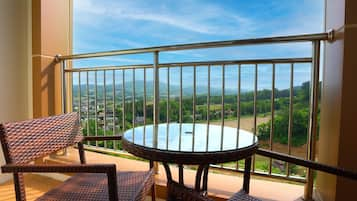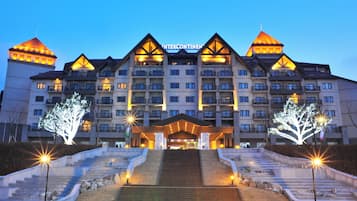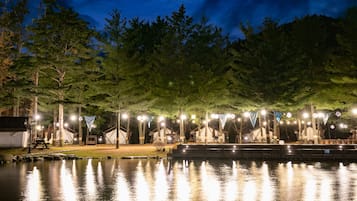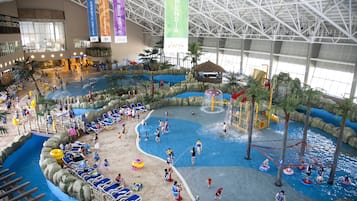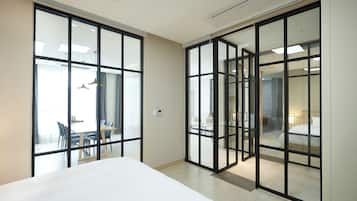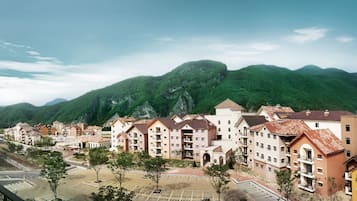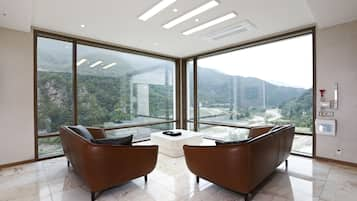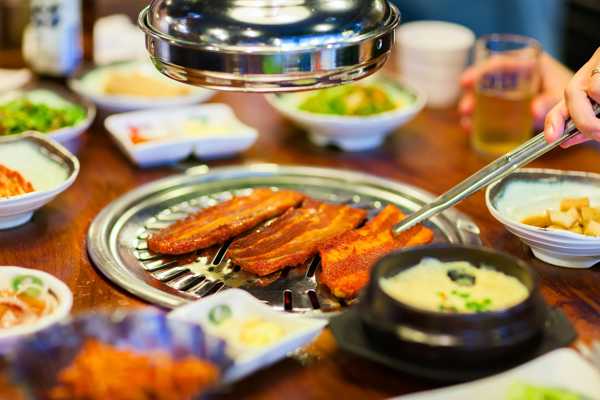In Pyeongchang, not only national treasures and regional treasures, which are nationally designated cultural properties, but also many folk materials and historic sites, as well as many designated cultural properties of Gangwon-do are preserved. The county is located in the Taebaek Mountain Range and there are rows of high peaks rising over 1,000 metres, including Odaesan Mountain, Taegisan Mountain and Gyebangsan Mountain. There is a legend that King Taegi of Yemaekguk founded the country during the time of the tribal state.
Visit Woljeongsa Temple, a thousand-year-old temple built during the Silla period, and take a look at the Octagonal Nine-storey Stone Pagoda, which is National Treasure No. 48. In addition, Woljeongsa Museum, which preserves and manages Buddhist statues, Buddhist paintings and Buddhist majestic articles for ornamentation from approximately 60 temples, is one of the must-visit places. Meet the Bronze Bell with a history of a thousand years at Sangwonsa Temple, where the statue of Manjusri Bodhisattva is enshrined. You can feel the wisdom of our ancestors who wanted to pass on history to the next generation at Odaesan National History Archives, one of the archive buildings storing 500-year-old Annals of the Joseon Dynasty. Seongyojang House, which shows the dignity of the Joseon Dynasty’s gentry, and Lee Hyo-seok Culture Village, which shows the world of modern literature, are also must-visit places. Stop by historical landmarks hidden throughout Pyeongchang and step back into its past.
- 1
Lee Hyo-seok Culture Village
World of literature found in Bongpyeong, where buckwheat flowers bloom

- Budget
- Families
- History
- Photo
Hyoseok Culture Village in Bongpyeong is the place where Gasan Lee Hyo-seok, the author of “When Buckwheat flowers Bloom,” which was chosen as a monumental short storey in the history of Korean modern literature, was born and grew up. It is also the actual background of the work about the life and sorrows of an itinerant vendor selling goods wandering around Bongpyeong, Gangwon-do in the 1930s. Along the Hyoseongmunhak-gil, you can find the Lee Hyo-seok Memorial Hall, Hyoseok Moonlight Hill, which is a theme park, the birthplace of Lee Hyo-seok, and the Literature Forest. At the Memorial Hall, you can see his handwritten manuscripts and articles that contain the life and world of Lee Hyo-seok, as well as various materials that provide insights into the times. You can meet the space of memories at the theme park, in which the characters and the scenes of the story were reproduced.
In early fall, when buckwheat flowers bloom around the hillside, the Pyeongchang Hyoseok Cultural Festival, where nature and literature come together in harmony, takes place. Local residents participate and volunteer in the cultural festival where you can look back on the author’s literary spirit and the value of his works. Make unforgettable memories while enjoying a variety of performances and experience events with the vast fields of buckwheat flowers in the background.
Location: Changdong-ri, Bongpyeong-myeon, Pyeongchang-gun, Gangwon-do, South Korea
Open: Daily from 8 am to 8 pm
Phone: +82 (0)33-330-2700
Map - 2
Woljeongsa Temple
Temple with a spirit of a long history

- Budget
- Families
- History
- Photo
Woljeongsa Temple is a thousand-year-old temple built by monk Jajang-yulsa upon his return after studying with the Tang Dynasty in 643 during the Silla Dynasty. It is said that he built a small temple and stayed there to meet the Manjusri, who gave him the surplice and the sarira of the Buddha while studying with the Tang Dynasty. After walking along the dense fir forest trails in the quiet atmosphere of the green coniferous forest and crossing the Geumgangyeon, you will come across the Cheonwangmun Gate. After going into the entrance and passing through the pavilion and Daebeopryunjeon Hall, you will find Jeokgwangjeon Hall where the figure of Sakayamuni is enshrined. The Octagonal Nine-storey Stone Pagoda in the courtyard of Jeokgwangjeon Hall, National Treasure No. 48, is one of the most important cultural properties. It is a stone pagoda representing the Goryeo Dynasty with a height of 15.2 metres, where the sarira of the Buddha is stored. In front of the pagoda sits the figure of a seated stone Bodhisattva making a Buddhist offering on bended knees as if she wants to find enlightenment.
Although being destroyed several times by fire and during the Korean War, it was restored into its present form thanks to the efforts of Buddhist elders, including Buddhist monk Tanheo, who reconstructed Jeokgwangjeon Hall after the Korean War. If you climb the high hill behind Daeungjeon Hall, you are rewarded with a panoramic view of Woljeongsa Temple.
Location: 374-8, Odaesan-ro, Jinbu-myeon, Pyeongchang-gun, Gangwon-do, South Korea
Open: 24/7
Phone: +82 (0)33-339-6800
Map - 3
Sangwonsa Temple
Temple enshrining the statue of Manjusri Bodhisattva, a symbol of wisdom

- Budget
- Families
- History
- Photo
The former name of Sangwonsa Temple is Jinyeowon, which is said to have been built by Buddhist monk Jajang-yulsa of Shilla together with Woljeongsa Temple. It is a temple which enshrines the statue of Manjusri Bodhisattva, the symbol of wisdom. It is a temple located on the hillside stretching from Woljeongsa Temple to Birobong and is known as one of the top Buddhist educational institutions in Korea. It has all the conditions to study and practise Zen meditation, so it is a place where many monks and Buddhists from all over the country come to cultivate the merciful heart of Buddha.
An important cultural property of the temple, the Bronze Bell with a height of 1.67 metres and a diameter of 91 centimetres, was made in 724 during the reign of King Seongdeok of Silla. The Bronze Bell is National Treasure No. 36 and is known as the oldest bronze bell in existence. You can also see the statues of Child Manjusri and Bodhisattva Manjusri, who is said to have healed King Sejo in the Joseon Dynasty, and Bodhisattva Manjusri, and National Treasure No. 292 for Epistle commemorating the renovation of Sanwonsa Temple, which King Sejo wrote for Sangwonsa Temple. There is a famous story about monk Hanam, who impressed soldiers who were originally planning to burn the temple during the Korean War so much so that he compelled them to only burn the doors to make smoke. Find the traces of painful history at Sangwonsa Temple.
Location: 1211-14, Odaesan-ro, Jinbu-myeon, Pyeongchang-gun, Gangwon-do, South Korea
Open: 24/7
Phone: +82 (0)33-332-6666
Map - 4
Bronze Bell of Sangwonsa Temple
Buddhist bell of the Silla Dynasty with a long history

- Budget
- Families
- History
- Photo
The Bronze Bell of Sangwonsa Temple, National Treasure No. 36, is the oldest bell in existence. It was cast in 725 during the reign of King Seongdeok of Silla, and is a representative Buddhist bell which has all the features of Korean bells. It was made 45 years before the Sacred Bell of Great King Seongdeok in Gyeongju, which is called the Emille Bell. It was originally hung at a gate tower in Andong, Gyeongsangbuk-do, but was transferred to Sangwonsa Temple during the midpoint of the Joseon Dynasty.
The bell stands 1.7 metres high and 91 cm wide. You can also see 8th-century sculptures of celestial maidens flying in the sky while playing a musical instrument. It has a convex body with lower and upper rims that are narrower than the centre, and a poroe (dragon) adorning the top of the bell. It is said that the dragon adorning the top of the bell is holding the heavy bell with mystical powers and shakes its body every time the bell tolls so that the sound travels further. It is also said that the unique patterns of lotus flowers and vines carved at the striking point with a wooden drum help the sound resonate. Feel the breath of a thousand years while looking at the Bronze Bell.
Location: 1211-14, Odaesan-ro, Jinbu-myeon, Pyeongchang-gun, Gangwon-do, South Korea
Open: 24/7
Phone: +82 (0)33-332-6666
Map - 5
Seongyojang House
Traditional house preserving the dignity of the household of the gentry

- Budget
- Families
- History
- Photo
Seongyojang House in Gangneung, which preserves the appearance and tradition of houses of the upper class, was designated as National Folklore Cultural Heritage No. 5 in 1967. It is said that it was built in a great location that was accidentally found by a 11th generation descendent of Prince Hyoryeongdaegun, Lee Nae-beon, who moved from Jeonju to Gyeongpodae. The name Seongyojang was derived from “Baedari Village,” a village which is said that people had to cross the wide Gyeongpo Lake by boat. By extending over ten generations since 1703, it became what it is today and retains the atmosphere of its 300-year history. It is a typical Korean traditional 99-kan house that has both the closeness of the northern part and the openness of the southern part and shows off the magnificence of the household of the gentry.
It is famous for Yeolhwadang, an elegant 12-kan Sarangchae, Anchae, Dongbyeoldang, and Hwallaejeong, a pavilion which looks like it is floating on an artificial pond. A pine tree standing on the round island over the pond viewed from the pavilion creates a picturesque scene. You can get a glimpse of the delicate craft works and lifestyle of the time from the various boudoir crafts, wooden furniture and living relics displayed in the Folk Material Exhibition Hall. Walk leisurely on Cheongryong-gil on the left side of the Seongyojang and the Baekho-gil on its right side, feeling the dignity of the nobles.
Location: 63, Unjeong-gil, Gangneung-si, Gangwon-do, South Korea
Open: Monday–Sunday from 9 am to 6 pm
Phone: +82 (0)33-648-5303
Map - 6
Jeokgwangjeon Hall of Woljeongsa Temple
Buddhist hall guarding Woljeongsa Temple

- Budget
- Families
- History
- Photo
Jeokgwangjeon Hall of Woljeongsa Temple is the main Buddhist Hall located in the centre of Woljeongsa Temple. It enshrines the Sakyamuni Buddha in the form of a Buddha statue in Seokguram as the main Buddha. In most temples, Sakyamuni is enshrined in Daeungjeon Hall, which is the centre of the temple, and the Vairocana Buddha, which is the main Buddha of the Avatamska Sutra, is enshrined in Jeokgwangjeon Hall. At Woljeongsa Temple, the Sakyamuni Buddha is uniquely enshrined in Jeokgwangjeon Hall. It is because the temple was aimed at enshrining the Vairocana Buddha of the Avatamska together with Sakyamuni, as the idea of Avatamska was widely spread from Odaesan Mountain, which is a Buddhist sacred place.
Before being burned during the Korean War, Chilbulbojeon Hall enshrined the Seven Buddhas. Present-day Jeokgwangjeon Hall was rebuilt in 1969 with native trees from Odaesan Mountain as the exterior columns and fir trees from Odaesan Mountain as the interior columns at the decision of monk Tanheo. It is a large Buddhist hall and has splendid and majestic dancheong with a hipped-and-gable roof having five-kan on the front and four-kan on the sides. There is Simwoodo on the outer wall, which is a picture showing the process of finding one’s true nature and achieving the enlightened state, so it is recommended to take some time for quiet reflection.
Location: 374-8, Odaesan-ro, Jinbu-myeon, Pyeongchang-gun, Gangwon-do, South Korea
Open: 24/7
Phone: +82 (0)33-339-6800
Map - 7
Woljeongsa Museum
Specialized museum to learn about the long history of Buddhism
- Families
- History
The Woljeongsa Museum preserves Buddhist statues, paintings, and articles for ornamentation and ritual ceremonies from approximately 60 temples in Gangwon-do. To protect the cultural assets and Buddhist remains stored at Woljeongsa Temple against fire, theft and destruction, Great monk Manwha started building Bojanggak in the precincts of the temple in 1974. The museum preserves articles on exhibition from natural or artificial damage and provides an open cultural space for visitors and Buddhists to see the displays.
The museum, which was opened in 1999, is a building with two storeys above ground and two underground levels, with exhibition rooms on the first and second floors. It contains 56 state-designated cultural properties, including the two National Treasures of Woljeongsa Stone Seated Statue of Bodhisattva and Sanwonsa Jungchang Kwonseonmun, and five Treasures. You can see 620 valuable cultural properties including tangible cultural properties of Gangwon-do. In addition to exhibiting and preserving cultural assets and relics, it also operates a museum cultural academy to understand Buddhism through temple architecture, Buddhist art lectures, and field trips.
Location: 176, Odaesan-ro, Jinbu-myeon, Pyeongchang-gun, Gangwon-do, South Korea
Open: Daily from 9.30 am to 4.30 pm (last entry 4 pm)
Phone: +82 (0)33-339-7000
Map - 8
Odaesan National History Archives
Place where the spirits and souls of our ancestors are recorded
- Families
- History
- Photo
The Odaesan National History Archives was built in 1606 to the annals of the Joseon Dynasty and royal genealogical records. The archives were located at the foot of Namhoam, between Woljeongsa Temple and Sangwonsa Temple. The annals is a record of the state affairs and activities of Joseon kings. Because unbiased recording and safekeeping of the annals were strictly confidential – not even the king was allowed to view the contents.
Multiple copies were stored in several archives as protection against disasters such as war and fire. The archives stored a proofread copy of the only remaining annals in Jeonju Historical Archives during the Japanese Invasion of Korea in 1592. A total of 788 volumes had originally been stored for 472 years spanning from King Taejo to King Cheoljong, but during the Japanese colonial period, they were forcibly moved to Tokyo University. Only the remaining 74 volumes have been returned and stored in Gyujanggak, the royal library of the Joseon Dynasty.
Location: 713-77, Odaesan-ro, Jinbu-myeon, Pyeongchang-gun, Gangwon-do, South Korea
Phone: +82 (0)33-330-2399
Map - 9
Lee Seung-bok Memorial Hall
Exhibiting the pain of division and the importance of national security
- Families
- History
- Photo
Lee Seung-bok Memorial Hall, located in Yongpyeong-myeon, was established to commemorate the anticommunist spirit of Lee Seung-bok, a boy who was killed after shouting “I hate the communists” during the “infiltration of armed communists into Uljin and Samcheok” in 1968. As a historical site showing the pain of national division and the gloomy life at that time, the Gyebang Branch School of Soksa Elementary School, where Lee Seung-bok attended, has been renovated and turned into a general memorial hall.
The exhibition hall is organized by theme, including an exhibition room with 13 oil paintings of the life of Lee Seung-bok and 33 of his articles and an exhibition room with 106 pieces of equipment of armed communist guerrillas of the North Korean military who committed atrocities. You can watch a documentary film in the main building about Lee Seung-bok and his family’s tragedy at the scene of brutal atrocities. Visit the Education Promotion Hall, Nature Learning Exhibition, and Folklore Library as well. A wildflower complex and military equipment including tanks and combat aircraft used during the Korean War are displayed outside the hall. In addition, you can feel the life of that time through the restoration of the birthplace of Lee Seung-bok’s family, who were slash-and-burn farmers.
Location: 327-2, Nodong-ri, Yongpyeong-myeon, Pyeongchang-gun, Gangwon-do, South Korea
Open: Summer: daily from 9 am to 6 pm. Winter: daily from 9 am to 5 pm
Phone: +82 (0)33-332-4323
Map - 10
Buseoksa Temple
Temple to escape the world and rest for a while
- Families
- History
- Photo
Located on Baekseoksan Mountain in Pyeongchang, Buseoksa Temple is the headquarters of the Samronjong, one of 27 Buddhist orders. Belonging to the Taebaek Mountain Range, 1,365-metre-high Baekseoksan Mountain forms the majestic shapes of mountains in Pyeongchang along with Jamdusan Mountain, Baekjeoksan Mountain and Jungwangsan Mountain. The Samronjong was established in 1989 by famous calligrapher Daesan Master Lee Hye-bong and is the order which serves Buddha with Seungrang Daejongsa (most eminent monk) of the Goguryeo Dynasty as the founder. Although lacking a long history, many monks from around 300 temples practise under this order. Every year, there are events such as the anniversary of the founding, a tea ceremony for the Seungrang Daejongsa, a Buddhist prayer service for national prosperity and the welfare of the people, and a pilgrimage programme. You can participate in the events if you plan your schedule accordingly.
The valley water flows along Arangchigol next to the temple with a refreshing sound, and the wonderful natural environment is surrounded by wild flowers and thick pine forests. Within the precincts, you will see the beautiful belfry. Stop by Daeungjeon Hall and Jijangjeon Hall, which have beautiful dancheong, and try forgetting about worldly anguish for a moment and seek the mind of Buddha. The golden Buddhist statue seated in meditation and the hundreds of sculptures of the baby bodhisattva under the sheeting joint rock will compel you to put your hands together in a prayer position. The view from Samseonggak Shrine is magnificent, which can only be seen at a mountain temple.
Location: 306-74, Hwaui-gil, Jinbu-myeon, Pyeongchang-gun, Gangwon-do, South Korea
Phone: +82 (0)33-333-7682
Map





